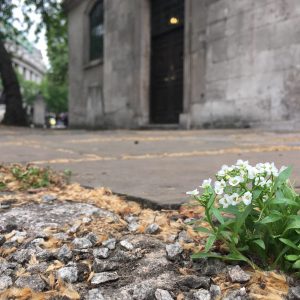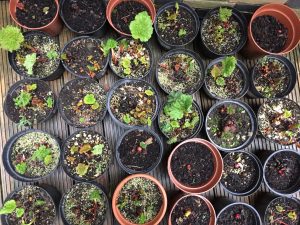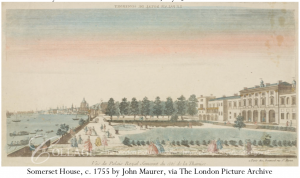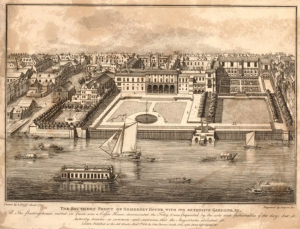Greening Aldwych Stop 7: Somerset House
Cross over to Somerset House and find a place in the courtyard to sit or stand.
Or, return to Stop 6: St Mary le Strand.
Aldwych Bees
By Fran Allfrey
While researching the green credentials of Aldwych I came across so many bee facts I had to share them.

Ideal bee snacks outside St Clement Danes, 30 May 2019.
Most of us know that, across Europe, bees are under threat. A monoculture of crops and pesticides endanger their habitat in countryside. However, perhaps unexpectedly, parks and gardens in city it turns out are really good for bees. There is year-around food for bees in London because of the way the parks and gardens are managed.
According to University of Sussex researchers, between 2008 to 2013 the number of beekeepers in Greater London tripled from 464 to 1,237. Their research has found "there are 10 times more hives per square kilometre in London than in rural Britain. This sudden increase of the urban bees has led to colony competition, the spread of bee diseases, and the exhaustion of flower supplies on which other insects – and, therefore, birds – live."
But there are plenty of practical things you can do to help bees, whether you live in the city or countryside. Bees love flowers, of course. They have a preference for blue, purple, violet and white flowers best, grown in large clumps in a sunny, sheltered spot.
And don't get over enthusiastic with your weeding! Dandelions, clover, and nettles all make a fine bee supper. Useful (for humans) herbs such as heather, lavender, rosemary and thyme are also sure to please. Friends of the Earth have a comprehensive list of good plants and other things you can do to help bees!
Why is this relevant to Aldwych? Well, there are honey bees on the roof of Somerset House, and businesses and universities along the Strand have installed bee boxes for solitary bees too.
Somerset House
By Clare Brant

Rhubarb plants, from Edible Utopia team member Clare Patey's website.
During our London History Day tour, 30 May 2019, we were lucky to be joined by Jane, from the Edible Utopia project. We learnt that the Edible Utopia team has been growing oyster mushrooms in the old coalholes of Somerset House! Using spent coffee grounds from the cafes as a medium, the idea is to supply on site restaurants with fresh mushrooms – with no food miles.
There is also a scheme to grow rhubarb in the so-called 'deadroom', the basement underneath the central courtyard and home to gravestones from the 17th century. One commemorates the gardener’s wife, Catherine Guilermet.
We also learnt from Jane that because Somerset House is a listed building (Grade I), no changes can be made to its appearance. No plants can be added and the courtyard must be weeded!
But, it seems Somerset House may never likely revive the courtyard gardens that once made it famous.

Somerset House c. 1755, by an unknown engraver, after John Maurer, via The London Picture Archive
Somerset House began as a palace for Lord Somerset, protector of the realm and uncle of Edward VI. After his disgrace, it was used by queens – first Anne of Denmark, then Catherine of Braganza. A map and ground-plan of old Somerset, or Denmark House in 1706, shows that it consisted of one large and principal quadrangle, called "the Upper Court," facing the Strand. Its out-buildings were very extensive, and still more so its terraced gardens, facing the Thames, with stairs at either end.
The gardens were laid out in the square and monotonous style of the period, so well described by Pope:
"Grove nods to grove, each alley has its brother,
And half the garden just reflects the other."

Bird's eye view over Somerset House, with the coffee house visible to the left, British Museum via Layers of London.
This was literally true here, for in front of both the greater and the lesser quadrangle there were square gardens, with straight gravel walks on each side, and three avenues of trees; a handsome flight of stone steps with iron gates; and on either side, statues of Tritons and Nereids. Along the river ran a raised terrace, with a heavy dwarf wall.
In a print of the river front of Somerset House, dated 1706, there appears moored a little way off the stairs a sort of house-barge, under which is written "The Folly," and a queershaped wherry, approaching the form of a gondola.
The so-called "Folly" was in fact a controversial floating coffee-house (read more of it on this Strandlines post). Plus ça change?
Stop 8: The Future of Aldwych
Find a place to sit, perhaps along the river at Somerset House, or in the Courtyard, and read more about the proposed future of Aldwych. And fire up your creativity! We'd love to hear your ideas for the new space.
>>> Stop 8: The Future of Aldwych
<<< Stop 6: St Mary le Strand
